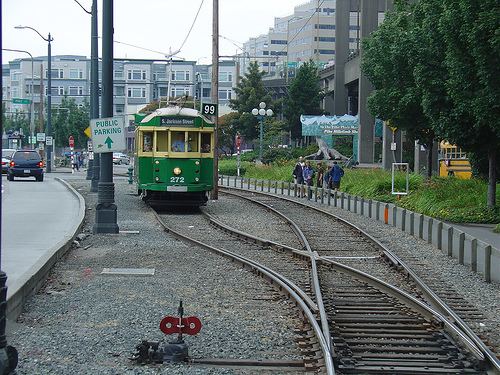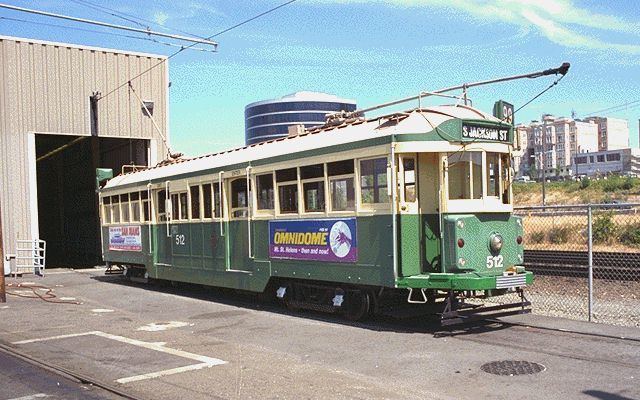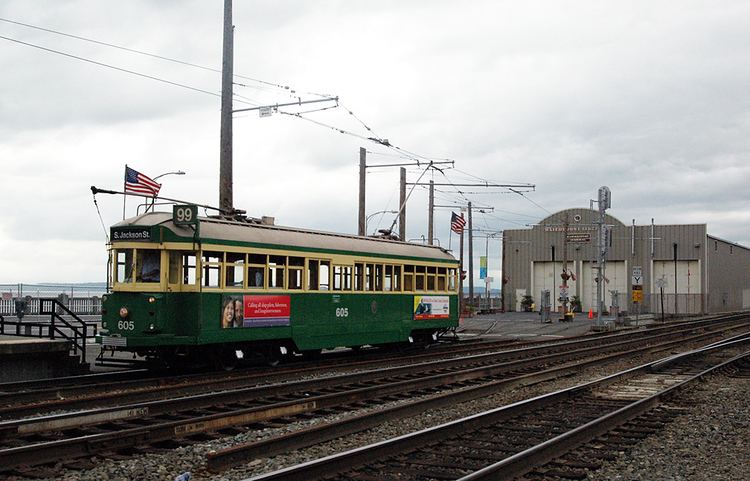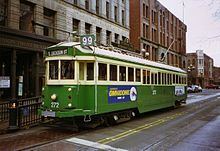Services 1 | Status Discontinued Opened May 29, 1982 | |
 | ||
Termini Broad Street at Alaskan WayJackson Street at 5th Avenue Stations 9 (4 standing, 5 demolished) | ||
Seattle featuring the waterfront streetcar and more
The Waterfront Streetcar, officially the George Benson Waterfront Streetcar Line, was a 1.6-mile (2.6 km)-long streetcar line run by King County Metro in Seattle, Washington, so named because much of its route was along Alaskan Way on the Elliott Bay waterfront.
Contents
- Seattle featuring the waterfront streetcar and more
- Seattle waterfront streetcar
- History
- Route
- Stations
- References

Service began on May 29, 1982, the first streetcars to run in Seattle since the closure of the Seattle Street Railway on April 13, 1941.

Service was officially suspended on November 18, 2005, when the maintenance barn and Broad Street station were demolished to make room for the Seattle Art Museum's Olympic Sculpture Park. A large portion of the trackage and four additional stations were demolished in spring 2012 as part of the construction project drilling a deep bore tunnel to replace the Alaskan Way Viaduct.

Streetcar service was replaced by King County Metro Route 99, which operated along Alaskan Way until February 2011 when construction forced Metro to reroute the line to 1st Avenue.

King County Metro announced in January 2016 that a private venture would launch a fundraising effort to retrofit two of the historic Waterfront Streetcar vehicles to run alongside modern Seattle Streetcar vehicles on the Center City Connector along 1st Avenue.

Seattle waterfront streetcar
History
Service began on May 29, 1982, which was the first streetcar run in Seattle since April 13, 1941. The first three streetcars had been brought to Seattle from Melbourne, Australia, by George Benson (1919–2004), a former pharmacist, who was a Seattle City Councilman from 1973 to 1993. They had been Melbourne and Metropolitan Tramways Board cars 482, 512 and 518, and they kept those numbers in Seattle. Two more Melbourne streetcars were acquired between 1990 and 1993. All were W2-class trams that had originally been built between 1925 and 1930. In 1990, the line was extended by one-quarter mile, along Main Street and 5th Avenue, to Jackson Street, to connect to the International District/Chinatown Station of the then-new Downtown Seattle Transit Tunnel. The extension opened for regular service on June 23, 1990. The line's fourth ex-Melbourne streetcar, No. 272, entered service earlier that month. A fifth car of the same type, No. 605, entered service on June 1, 1993.
The streetcar ceased operation on November 18, 2005, when the maintenance barn was demolished to make room for the Seattle Art Museum's Olympic Sculpture Park. A new maintenance barn was proposed to be built at Occidental Park to allow the resumption of operations as early as summer 2007. However, Metro cancelled involvement after delays made the new facility unlikely to be completed before the demolition of the Alaskan Way Viaduct began. An alternative proposal by the Port of Seattle was to extend the line northward along Myrtle Edwards Park to Smith Cove, where a new maintenance barn would be built on Port property. This proposal was not pursued.
In 2007, two years into the suspension of service, the route was named by National Geographic Society as one of the 10 Great Streetcar routes.
In spring 2012, a large portion of the trackage and the stations at Pike, University, Madison and Washington streets were demolished in as a part of the construction project drilling a deep bore tunnel to replace the Alaskan Way Viaduct.
The City of Seattle began studying the possibility of bringing streetcars back to the city center in late 2012. The locally preferred alternative for this project adopted in late 2014 supported a route along 1st Avenue and not Alaskan Way. James Corner Field Operations, the Manhattan-based landscape-architecture firm hired to recommend a new vision for the Seattle waterfront once the Viaduct has been demolished, also recommended the Streetcar not be returned to Alaskan Way, but to nearby First Avenue instead.
While future plans for the line were determined, the streetcars were stored in an old warehouse in SoDo for more than a decade. In 2015, the Federal Transit Administration informed King County that if the streetcars are not put back in service soon, Metro would need to pay $205,000 to compensate the agency for its remaining investment in the cars. At the same time, the warehouse used to store the streetcars was in poor condition and the land needed for expansion of a neighboring bus base.
In January 2016, it was announced that a private venture, Friends of the Benson Trolleys, was intending to raise the money required to retrofit two of the streetcars to allow them to be used on the future Center City Connector on 1st Avenue. The plan closely mirrors one suggested in May 2009 by then Seattle Mayor, Greg Nickels. The remaining three cars were sold by King County to St. Louis, for use on their planned heritage Delmar Loop Trolley, for which they will need several modifications before they can be used; only one car is being retrofitted (by Gomaco) for service in St. Louis initially. The specific cars sold to St. Louis were Nos. 482, 512, and 518, and they left Seattle in early June 2016. The streetcars retained by King County Metro are Nos. 272 and 605 (along with 525, which never entered service, and has been kept only as a source of parts). Because the warehouse in which they had been stored since the end of Waterfront Streetcar service in 2005 was due to be torn down, to make way for expansion of a Metro bus garage, the streetcars were moved out in early June 2016, to a private site in Arlington, Washington, where they will be stored indefinitely, awaiting possible future developments in the proposals for their return to service.
Route
The line ran mostly northwest-southeast along Alaskan Way on Burlington Northern and Santa Fe Railway trackage. From S. Main Street in Pioneer Square east to 5th Avenue S. it ran in the center median, with its last block on the west side of 5th Avenue between S. Main and S. Jackson Streets. The line ended at a station near Broad Street, with the maintenance barn located immediately north of the station.
Stations
All of the stations (with the exception of the Occidental Park and Jackson Street stations) along the Alaskan Way were originally painted brown when the line first opened. In 2004, all of these stations were repainted in Marine Blue and refurbished. The Occidental and Jackson stations were designed to reflect the surrounding architecture along the streets when the line was extended in 1990. The Jackson Street stop featured an Asian Pagoda-style station while Occidental park had a vintage-style station.
